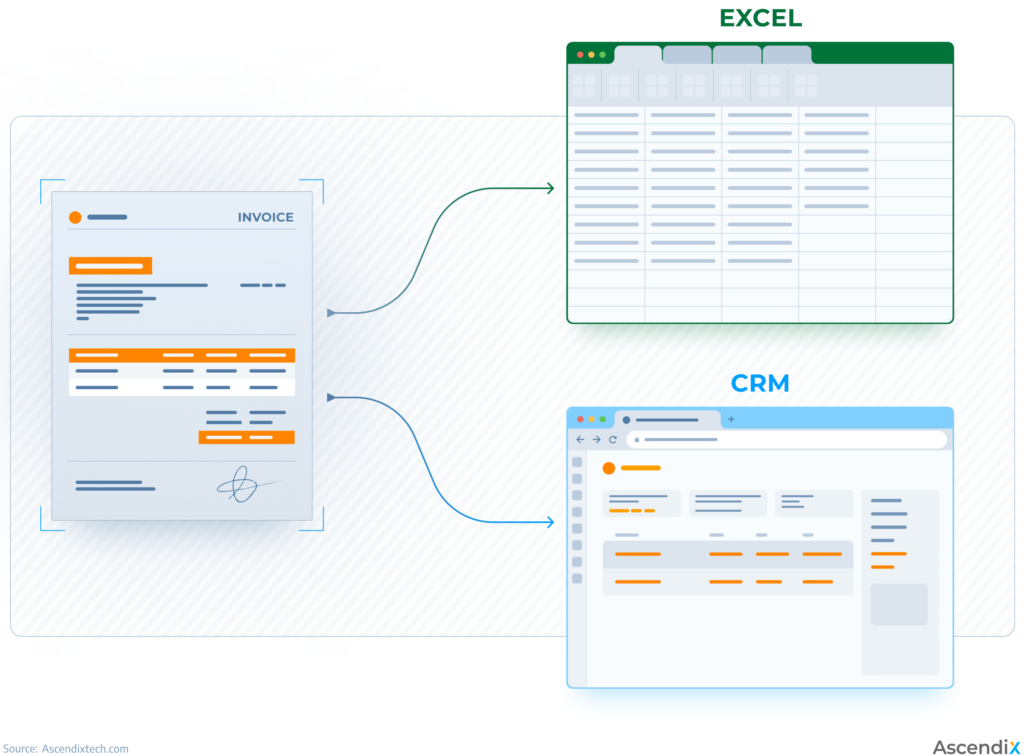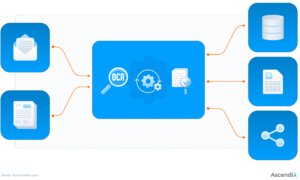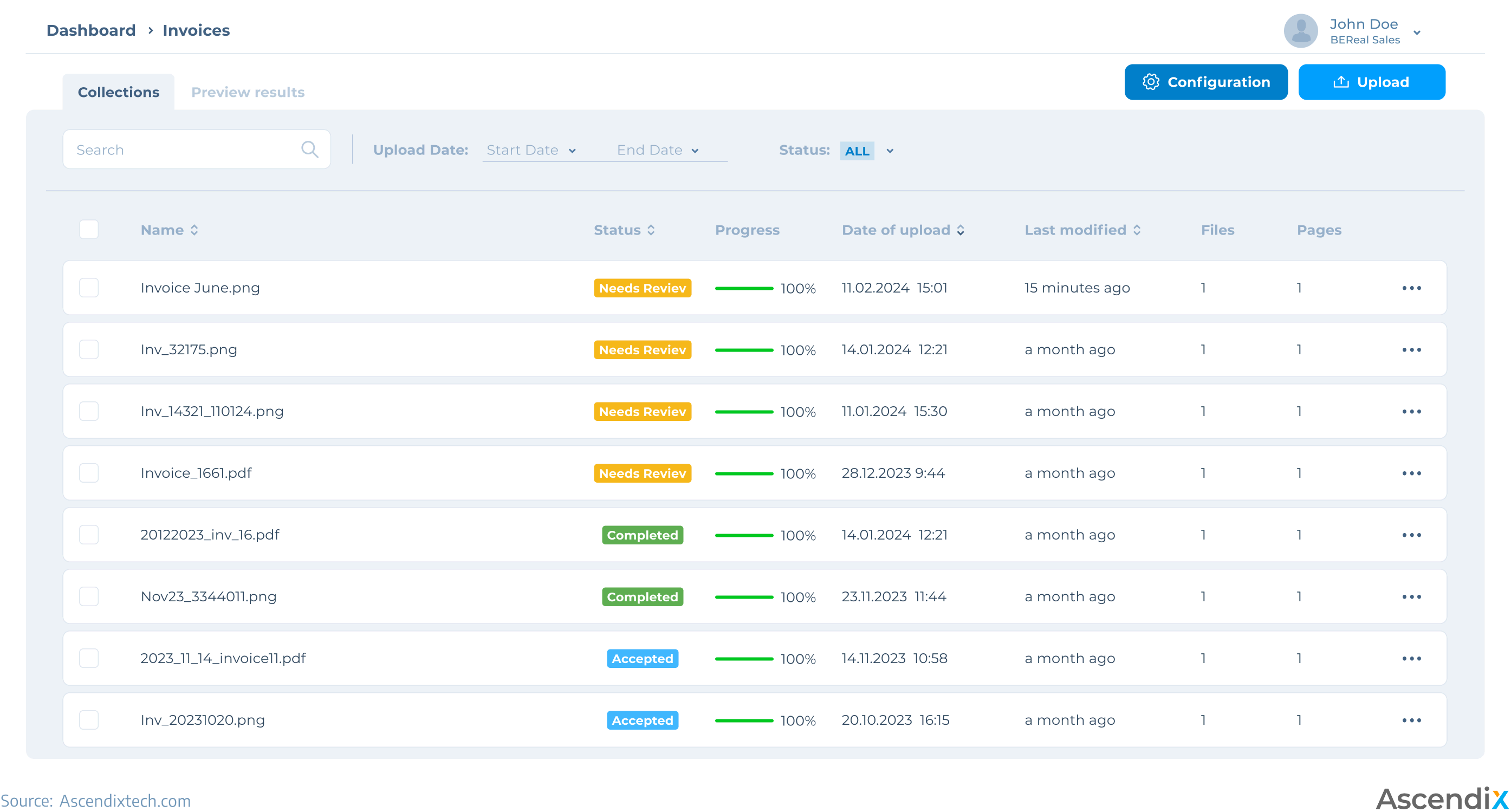Want to Integrate AI into Your Existing Software?
See how Ascendix can help you optimize your operations and improve your workflow with the help of AI.
In document-heavy industries like finance, insurance, accounting, and real estate, the constant need to input data from hard copy or digital documents into systems is a major bottleneck for business operations.
Invoices, purchase orders, lease agreements – they all require human scanning, data capture, and input, often leading to errors. And that’s assuming your employees don’t miss anything or forget to input it into the system.
But with AI data entry, that’s a thing of the past. Powered by AI, data entry automation technology captures key data, extracts it, and automatically inputs necessary segments into relevant data fields in the system – a huge time-saver for employees and a money-saver for companies.
In this article, we explore how AI can revolutionize data entry processes by automating manual data entry and maintaining accuracy, precision, and efficiency for any document-heavy industry.
Automated data entry, also known as automated data capture, is the process of automatically collecting and inputting data into digital systems like CRM without manual intervention. This technology helps streamline repetitive tasks related to large dataset processing, reduce errors, save time, and improve productivity in data entry manual processes.
AI data entry uses artificial intelligence (AI) and machine learning (ML) algorithms, strengthened by technologies like optical character recognition (OCR) data entry, natural language understanding (NLU), and natural language processing (NLP), to ensure high-quality data management.

Automated data entry is versatile and can manage a wide range of data types and applications, including customer details, employee records, product information, financial transactions, and more. Due to this, data entry automation can be used in all industries that work with large amounts of data, for instance, in legal, tax, accounting, e-commerce, real estate, insurance, finance, HR, and many others.
AI data entry automation works by using AI algorithms to get the data from available sources and then insert it into CRM or databases. Optical Character Recognition (OCR) converts text from scanned documents into machine-readable format, while Natural Language Processing (NLP) extracts meaningful information from text to input into CRM or databases. The data is then cleansed, validated, transformed, sorted, and integrated into target systems.
The process begins with uploading the document containing the relevant data into the system or application. It may be a PDF, scanned image, handwritten notes, or other formats of collateral.
Next, Optical Character Recognition (OCR) technology scans the document, converting any text or images into digital format that the computer can understand. After OCR, Natural Language Processing (NLP) techniques analyze the text to understand its meaning and extract relevant information.
Overall, the technologies, used for data extraction, may be:

As the process of data extraction happens, AI data entry tools can identify uncertain elements within the analyzed document and request the user to check and correct them:

If ambiguous elements are detected, like unclear handwriting or an ink stain, the AI data entry system generates a request to the user, highlighting the specific areas that require validation, and the user inserts the right information.
Such an approach not only improves the accuracy of data entry but also ensures that potential errors or inconsistencies are addressed promptly, leading to more reliable and accurate data processing outcomes.
See how Ascendix can help you optimize your operations and improve your workflow with the help of AI.
The extracted data is validated to ensure accuracy and consistency. Validation rules and algorithms are applied to identify and correct errors, missing information, or inconsistencies in the data. The validation process may also be conducted by the human operator after the previous step of identifying inconsistencies.

After the data is validated and the errors and inconsistencies are corrected, the data may undergo transformation processes such as formatting, standardization, or cleaning to ensure uniformity and compatibility with target systems. This is an important step of AI for data entry, as it will define all the further processes of data entry into the CRM system.
The processed, standardized, and validated data is integrated into desired CRM systems, business databases, or any other applications. AI automated data entry frameworks may be integrated with existing software for data input, of the prepared data may be downloaded for any further use in convenient formats, like XLS, PDF, or others.

AI Data Entry | Ascendix

Making the correct choice between manual data entry and automated or AI data entry is crucial for businesses, as it will significantly impact operational efficiency and data management processes in the future.
Let’s compare aspects of manual and automated data entry to understand each approach’s strengths and limitations. This will help make an informed choice which will optimize data entry processes and enhance overall productivity.
| Aspect | Manual Data Entry | Automated (AI) Data Entry |
|---|---|---|
| Speed | Relatively slow, prone to human errors and delays | Fast data input, significantly shorter processing time |
| Accuracy | Higher chance of errors due to human input | Better accuracy provided that the AI is trained properly |
| Cost | Cheaper at the beginning, but has higher operational cost in the long run, since it is more labor-intensive and takes more employees’ time | Lower cost in the long run, but requires significant initial investment in AI at the beginning |
| Scalability | Limited scalability due to reliance on human resources; requires qualified staff and finances for upscaling | Easily scalable, as automated data entry is capable of handling large volumes of data |
| Integration with Systems | Requires manual effort for integration | Requires manual effort for integration at the beginning |
| Learning and Adaptation | Requires training and supervision by a more proficient employee | Can learn and adapt over time, improving accuracy |
| Data Complexity | May struggle with complex data formats or structures | Handles diverse data types and structures |
| Changes in Operations | Needs little change or adaptation, requires extra training | Needs a lot of adaptation and change in the structure, software, and training |
| Compliance Regulation | Depends on the quality of employee’s training and knowledge, may be susceptible to errors | Has minimum likelihood of compliance issues if trained properly |
Hire Ascendix and we’ll execute your vision and create a thriving AI tool or bootstrap your existing solution.
AI data automation tool will be the most beneficial for the big companies which handle large amounts of various documents and types of data and daily process the data, manage it, and work with the CRM or other types of databases.
Data entry automation is a versatile technology that can be applied successfully in any industry that involves extensive work with documents or handling big amounts of data. However, there are industries where it might seem the most effective.

Tasks performed by AI data entry tool:
Documents processed:
Results:
Tasks of AI data entry automation tool:
Documents processed:
Results:
Tasks performed by automated data entry tool:
Documents processed:
Results:
Tasks of automated data entry software:
Documents processed:
Results:
Tasks of automated data entry tool:
Documents processed:
Results:
Tasks of data entry automation tools:
Documents processed:
Results:
Tasks:
Documents processed:
Results:
AI data entry software is a game-changer for businesses managing extensive datasets in CRM systems. One of the best things about AI data entry automation tools in this context is their ability not just to extract data from documents but also to autonomously insert it into the CRM, saving countless hours of manual data entry.
AI data entry systems can accurately interpret and extract pertinent information from diverse documents like contracts, invoices, and forms. The data extracted may include customer details, transaction records, product information, and more. Data entry automation can streamline the entire data input process, eliminating the need for human intervention. This not only reduces the risk of errors but also significantly accelerates the speed at which data is processed and updated in the CRM.
Additionally, automated data entry systems can validate and standardize the extracted data against predefined criteria, ensuring accuracy, readability, and convenience in handling the data. The integration with CRM enables real-time updates, keeping customer profiles, sales records, and other vital information current and consistent.
This scalability and efficiency make AI data entry solutions a perfect solution for businesses aiming to optimize their CRM operations, improve productivity, and enhance decision-making.
Implementing custom AI data entry automation software offers multiple advantages for large organizations with huge document workflows. A data entry automation tool can replace manual data entry and offers tailored solutions, improved accuracy, integration with existing software, cost-effectiveness, scalability, competitive advantage, and innovation opportunities, making it a strategic investment for businesses with specific data entry needs.
Ascendix is an AI pioneer in software development, which combines deep knowledge of modern technology with expertise in real estate. We have established unique and substantial experience in fostering transformative change with the help of AI-driven software for different industries. Moreover, we have built custom AI software ourselves for data entry in various industries, which gave us significant practical experience in building frameworks for AI search, lease abstraction tools, AI recommendations, and other advanced software.
Why choose Ascendix as your partner to automate data entry?
How Ascendix can help you in AI data entry automation:
Hire Ascendix and get rid of manual data entry forever with your tailored AI data entry automation software. Schedule the free consultation today and investigate how to automate data entry with us.
Check out the overview of the proptech consulting and software development projects we delivered to our clients.
To use AI for data entry, start by identifying the types of data you work with, such as documents, forms, or emails. Then, develop an AI data entry tool, ensuring it has the required capabilities, such as natural language processing (NLP), machine learning (ML), and optical character recognition (OCR). Train the AI model and integrate the AI tool with your existing systems, such as CRM or database platforms, to automate data entry. This way, AI data entry tool will be tailored for your business needs and will work effectively and efficiently.
Yes, AI can perform data entry tasks. AI data entry automation systems use natural language processing, machine learning, and optical character recognition to extract information from documents, forms, emails, and images. The system then inputs the data into databases, CRM systems, or other software platforms automatically, replacing manual data entry and improving accuracy and efficiency.
While AI can automate manual data entry tasks, it will not fully replace data entry jobs. Instead, AI is more likely to streamline them by handling repetitive and routine data entry tasks. Human oversight and decision-making will still be required for handling exceptions, ensuring data quality, checking the inserted information, and interpreting nuanced information that AI may struggle with. While AI will transform the data entry processes, it’s more about reshaping the industry tasks than replacing data entry jobs.
AI is highly likely to replace manual data entry. With the help of data entry automation software, the most repetitive tasks like inserting the data from documents into the CRM will happen automatically. However, there is yet no way how to automate data entry from hand-written or signed documents and seamlessly integrate them into the CRM. Some critical and dubious aspects of AI data processing and data entry automation must still be overseen by the human operator, who would ensure that the inserted data is right.
Yana is a proptech enthusiast and a technology fan. In her articles, she explores the world of real estate software, including proptech news, useful resources, and real estate technology insights, assisting everyone involved in the industry to modernize and optimize their business.
Get our fresh posts and news about Ascendix Tech right to your inbox.